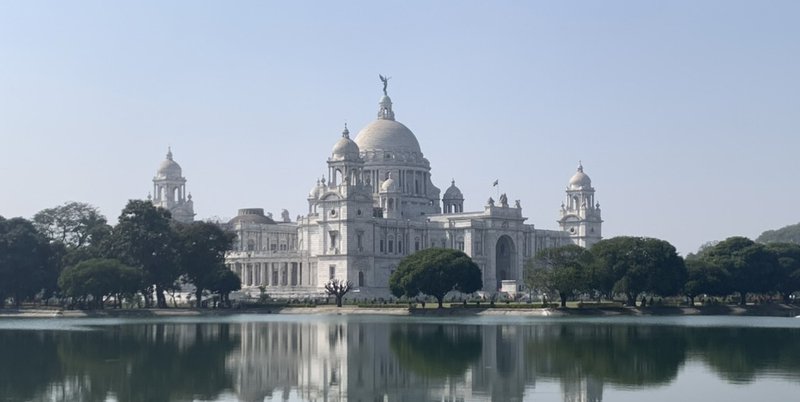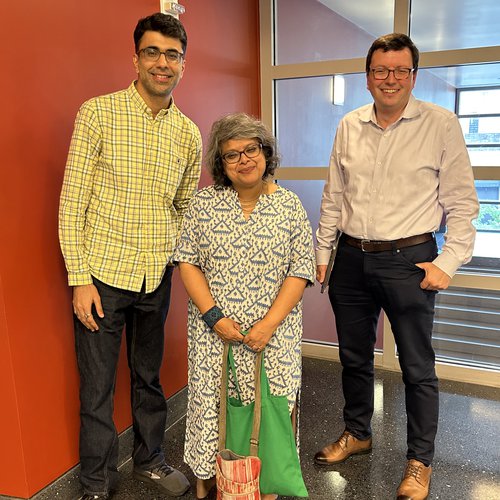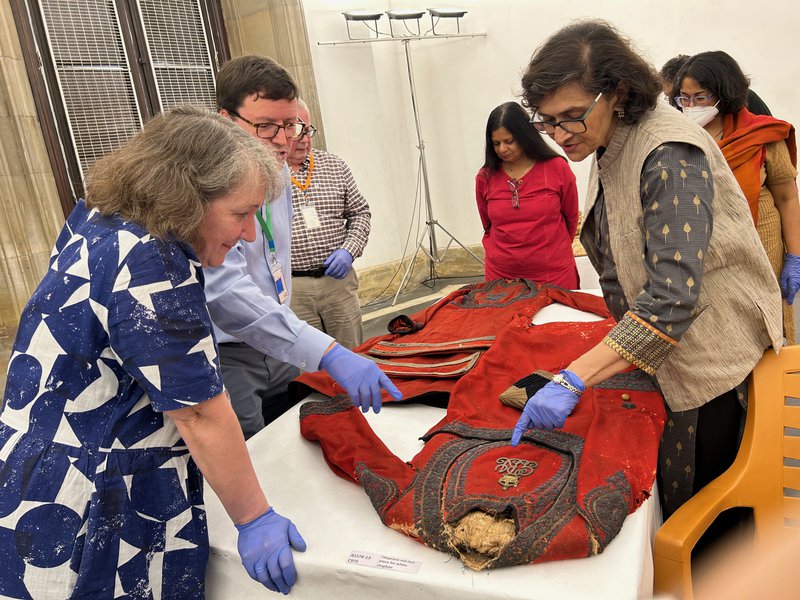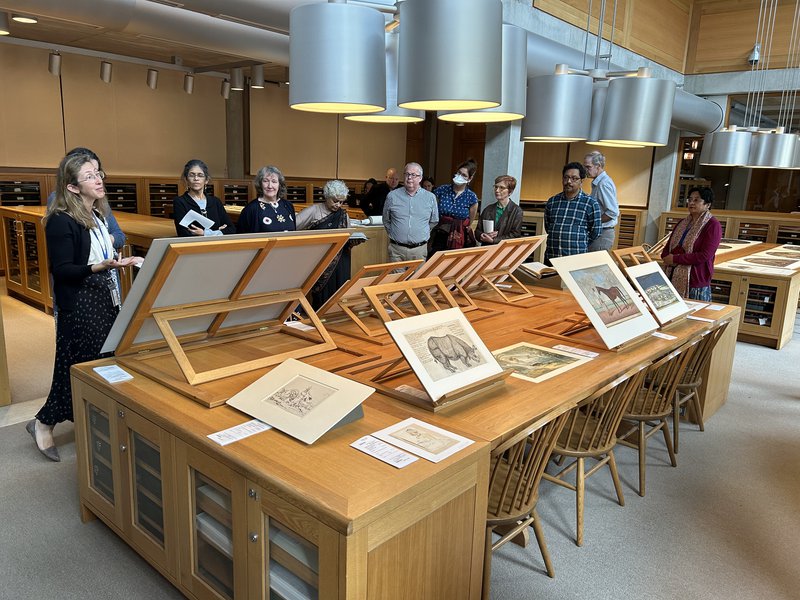A&S Art History Professor Co-Convenes International Team of Scholars to Explore the Imperial Histories of India’s Most Visited Museum
Over the past year, AMH Professor Romita Ray and a group of scholars have analyzed the history, architecture, gardens, plants and collections of the Victoria Memorial Hall in India, culminating in a symposium at Yale.

Victoria Memorial Hall, Kolkata. (Photo: Tim Barringer)
From the pyramids in Egypt to India’s Taj Mahal, famous buildings and monuments have been constructed for thousands of years to honor leaders or prominent personages. When Great Britain’s Queen Victoria died in 1901, Lord Curzon, a British statesman and viceroy of India from 1899 to 1905, ordered the construction of a grand memorial and museum in her honor. Built in Kolkata (formerly Calcutta) in eastern India, Victoria Memorial Hall (VMH) and its 57-acres of gardens opened to the public in 1921. The iconic museum is renowned for its rare Indian, Persian, British and European art, artifacts and manuscripts.
Just over 25 years after VMH was completed, the modern-day nation states of India and Pakistan gained their independence from Britain after nearly a century under the British Crown. The VMH, built as a tribute to Queen Victoria, has remained a conspicuous reminder of Britain’s imperial rule in a city that was once the capital of British India.
The museum’s collections, which include European paintings; colonial sculpture; historic photographs; musical instruments; textiles; and Mughal, Rajput, and Bengal School paintings, offer an invaluable glimpse of the visual legacy of the British Raj. Today, they shed light for researchers on how Indians, Britons and Americans shaped the imperial histories of the VMH—histories that are entangled with Curzon, arguably India’s most ambitious viceroy, and Victoria, who, in 1877, was proclaimed Empress of India.

Romita Ray, associate professor of art history at Syracuse University's College of Arts and Sciences, and Tim Barringer, Paul Mellon Professor of the History of Art at Yale University, convened academics from around the world at a symposium in September 2023 titled, "Taj of the Raj: The Victoria Memorial Hall, Kolkata," held at Yale. The international group of scholars converged at workshops and presented research papers over the course of five days to discuss new critical perspectives on the history, architecture, gardens and collections of the VMH, which is India's most visited museum. The symposium was supported by the National Endowment for the Humanities (NEH), Syracuse University and Yale University.
Taj of the Raj grew out of an NEH-funded collaborative research workshop in Kolkata in January 2023, where the interdisciplinary team of art and architectural historians, literary scholars, curators, cultural historians, botanists, garden historians, gardeners, anthropologists and historians of environmental studies gathered for a deep dive into VMH’s collections of art, artifacts and plants. With additional support from the Office of Research and the South Asia Center at SU, as well as alumnus Todd B. Rubin ’04, Minister of Evolution and President of The Republic of Tea, the team was also able to examine related collections in the Indian Museum, Calcutta Botanic Garden, Fort William Museum, Saint Paul’s Cathedral, Marble Palace, Raj Bhavan (Government House) and private collections.

Joanna Marschner (Historic Royal Palaces, UK), Tim Barringer (Yale University), Tapati Guha-Thakurta (Centre for Studies in Social Sciences Calcutta), Swati Chattopadhyay (UC Santa Barbara), and Durba Ghosh (Cornell University) studying imperial uniforms in the Victoria Memorial Hall.
“Rarely, if ever, do American, British, and Indian scholars come together onsite in India to unpack a monumental imperial complex like the Victoria Memorial Hall,” says Ray, whose research focuses on the art and architecture of the British Raj.
The team’s aim was to re-center the Indian histories of art making, collecting, engineering, botany and horticulture in the story of the VMH, and investigate how they are linked to British and American histories. Among the articles the team studied was a court dress worn by Lady Curzon, the American heiress married to Lord Curzon. The dress, made of silk from Benares, an acclaimed center for silk weaving in India, illustrates the link between Indian, British and American cultures. They also examined a painting depicting a royal procession in Jaipur, India, by late nineteenth century Russian artist Vasily Vereshchagin. For many years the painting was in the collection of Edward Malley, a wealthy Irish American businessman who lived in New Haven, Connecticut. The Maharaja of Jaipur purchased the artwork from Malley and eventually gifted it to VMH.
According to Ray, the onsite workshop in Kolkata was an exciting starting point of an in-depth and long overdue investigation of the histories of the gardens, architecture and collections of the VMH, which culminated in the Yale symposium.
“Members of the research team had several months to further explore and unpack their chosen focal points of research, before presenting them to each other and to students, faculty and curators at Yale,” she says.
During the symposium, members of the research team formally presented their results and studied rare books, prints, drawings, paintings and photographs related to their research projects at the Yale Center for British Art and the Beinecke Rare Book and Manuscript Library. They also engaged with curators of a forthcoming exhibition on colonial India at Yale.

Symposium attendees previewing a forthcoming exhibition on colonial Indian art with Holly Shaffer (Brown University) at the Yale Center for British Art.
Ray wasn’t the only Syracuse University connection to the symposium, as two Syracuse alumni who are now at Yale University were in attendance. They were Kasturi Gupta G’16, who is Director of Programs and Institutional Partnerships, South Asian Studies Council at Yale, and Ankush Arora G’23, art history alumnus, who is now a graduate student in the History of Art Department at Yale. Conference attendees also enjoyed tea from The Republic of Tea donated by Syracuse alumnus Todd B. Rubin.

Vinita Damodaran (University of Sussex), left, and Ankush Arora studying a rare book together.
The interdisciplinary and international nature of the hands-on workshop at Kolkata and the subsequent convening at Yale has made Taj of the Raj a very special project for Ray, who is a native of Kolkata herself.
“For me, personally, this symposium marked a full circle to my journey as an art historian who works on the British Empire in India,” says Ray. “My initial forays into this field of inquiry began when I was a student at Yale, whose museum and archival collections have deep holdings of materials related to British India. So, it was especially gratifying to bring together some of the world’s leading scholars who work in this area, to my alma mater, with Syracuse University alumni in attendance.”
Symposium speakers included Rimli Bhattacharya, University of Delhi; Manas Bhaumik, Botanical Survey of India, Kolkata; Swati Chattopadhyay, UC Santa Barbara; Edward Cooke, Yale University; Caroline Cornish, Royal Botanic Gardens, Kew; Vinita Damodaran, University of Sussex; Anshuman Dasgupta, Visva Bharati University, Santiniketan; Adam Eaker, The Metropolitan Museum of Art; Durba Ghosh, Cornell University; Tapati Guha-Thakurta, Centre for Studies in Social Sciences Calcutta; Margot Finn, University College, London; Michael Hatt, University of Warwick; Annu Jalais, Krea University; Nilina Deb Lal, Heritage Consultant, Kolkata; Joanna Marschner, Historic Royal Palaces, UK; Sumathi Ramaswamy, Duke University; Jayanta Sengupta, Victoria Memorial Hall; Holly Shaffer, Brown University; and Yuthika Sharma, Northwestern University.
The team aims to publish their research findings on a research website and in an edited volume, co-edited by Ray and Barringer.
Featured
Romita Ray Associate Professor and Director of Undergraduate Studies in Art History
